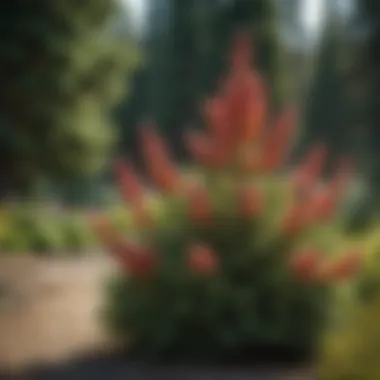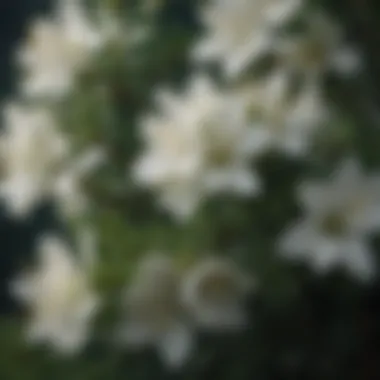Discover the Beauty of Flowering Evergreens in Full Sun


Intro
Flowering evergreens offer a unique and captivating aspect to landscape design. These plants execute a harmonious blend of aesthetics and functionality, ensuring spaces are adorned throughout the year. Their fascinating characteristics not only provide visual appeal but also serve crucial ecological purposes. This exploration seeks to shine light on these elegant plants that flourish in full sun, examining various types, their specific needs, and methods of integrating them effectively into outdoor areas.
The lush greenery paired with vibrant blossoms presents a striking contrast against sunny backdrops. Selecting the right flowering evergreen enhances not only the beauty of garden or patio but also creates an inviting atmosphere fitting for discerning individuals who appreciate luxury.
Throughout this article, readers will discover:
- The diverse types of flowering evergreens suited for full sun exposure
- Their maintenance requirements to ensure optimal growth
- Tips on creating stunning outdoor environments that emphasise these fascinating plants
- Insights into the role these evergreens play in ecological sustainability
- Recommendations to merge function and beauty in outdoor spaces
As we delve deeper, each section further aims to inspire thoughtful design, encouraging the optimistic prospect of integrating eco-friendly options into your exquisite outdoor environments.
Outdoor Decor Ideas
When conceptualizing outdoor spaces, flowering evergreens emerge as brilliant focal points. Their resilient nature permits integration into various landscape designs, propelling elegance in full sun environments.
Seasonal Inspirations
Emphasizing seasonal transitions becomes straightforward with carefully selected flowering evergreens. Certain varieties bloom at distinct times, introducing an evolving display throughout the year. Examples include the Rhododendron popular in early spring, or Hollies, which establish lush summer scenes followed by festive berries in winter.
Furniture Selection
Choosing complementary outdoor furniture can elevate the inital design scheme. Consider hard-surfaced seating options painted to resonate with the evergreen hues. Wicker finds can preserve breathable appeal while contrasting the verdant surroundings. Additionally, select materials that withstand outdoor conditions well.
Decorative Lighting
Illuminating these durable plants allows for a subtler nightly oasis. Effortlessly adopt string lights or solar-powered fixtures.
Influential illumination techniques include:
- Placing lights to waterfall along the curves of plants
- Ensuring light fixtures stay close to herbaceous perennials to highlight flowering traits
- Selecting soft warming tones, producing a serene ambiance
Plant Arrangements
Strategically plant flowering evergreens to optimize their aesthetic influence. Positioning them at key sightlines transforms spaces, naturally guiding visitors’ eyes throughout the gardens. It is important to marry height and depth variations while balancing plant thicknesse.
Hardscaping Solutions
Incorporating stone pathways or retaining walls beside flowering evergreens enhances textural contrasts. Selecting a natural stone provides scenery that seamlessly transitions into plant life. Incorporate functional elements like seat walls or fire pits for versatile entertaining options.
Sustainable Practices
Emphasizing ecological impact enhances design sense. Endeavor sustainability of the landscape by:
- Utilizing mulch at bed bases to protect against temperature fluctuation
- Selecting native flowering evergreens, guaranteed to thrive in local climates while supporting surrounding wildlife.
Considering these guidelines lays foundational aspects for spaces saturated with luxury. The combination of thoughtful selections work harmoniously to establish vibrant outdoor retreats.
Understanding Flowering Evergreens
Flowering evergreens are an intriguing group of plants that add both structure and color to landscapes throughout the year. They deliver continuous interest to gardens, appealing aesthetically and providing other essential benefits. Within this section, we will explore their definitions, characteristics, and the two main types: broadleaf evergreens and coniferous evergreens. Such knowledge is crucial for selecting the right specimens for your outdoor spaces, particularly in regions with full sun.
Definition and Characteristics
Flowering evergreens are perennial plants that retain their foliage all year while producing flowers in designated seasons. They are classified based on their leaf type; some, like holly or magnolia, feature broad leaves, while others, such as pines or spruce, have needle-like leaves. This distinction impacts their maintenance needs and adaptability.
Key characteristics include:
- Year-round structure: These plants serve as visual anchors.
- Diverse flowering periods: While blooming shows up at set times, the greenery persists, allowing size and architecture stability within the garden’s design.
- Adaptation to full sun: Most flowering evergreens thrive in bright settings, providing rich colors and habitats for local wildlife.


As you consider adopting flowering evergreens, understanding their unique natures enhances planning for landscapes.
Types of Flowering Evergreens
Two primary types of flowering evergreens dominate gardens: broadleaf and coniferous. These contribute differently to landscapes.
Broadleaf Evergreens
Broadleaf evergreens have large, often glossy leaves that do not fall in winter. One specific aspect of these plants is their ability to contribute vibrant hues during darker months. Examples such as Camellia sinensis and Nandina domestica add colorful blooms.
A key characteristic that stands out is adaptability. They flourish in various soil types and full sunlight conditions. This reputation for resilience makes them a popular choice among gardeners.
The unique starch storage system allows broadleaf evergreens to maintain vigor even in adverse conditions. The advantage lies in their consistent flowering, offering both aesthetic and practical implications for those seeking a diverse garden. However, some can demand more regular water and upkeep compared to other types.
Coniferous Evergreens
Conversely, coniferous evergreens, such as Juniperus communis or Pinus strobus, tend to display needle-like foliage and often thrive in draught-prone climates. Key characteristics include hardiness and low maintenance, being particularly suited for sun-drenched areas.
Their unique feature is adaptability to varying soil pH and structure. This makes them advantageous in untreated soil conditions prevalent in sunlit landscapes. Farmers and landscapers often appreciate the ease of care associated with coniferous evergreens, especially in full sun.
While these plants exhibit resistance to extreme environments, growers generally watch for potential fungal diseases, which lead to challenges. Nevertheless, their persistently appealing profiles make them indispensable for achieving cohesive garden designs.
By understanding the distinct features of broadleaf and coniferous flowering evergreens, one can select suitable options for enhancing full-sun landscapes.
The Importance of Full Sun
Full sun is often a decisive factor for the growth and vitality of flowering evergreens. Understanding this aspect ensures successful landscaping and a flourishing outdoor environment. Flowering evergreens that flourish in full sun typically boast robust growth and vibrant blooms, favored by gardeners and designers committed to enhancing their spaces. Strategically placing these plants in optimal sunlight not only maximizes their aesthetic qualities but also ensures their healthy development over time.
Understanding Sunlight Requirements
Sunlight plays a critical role in the health of flowering evergreens. These plants often require a minimum of six to eight hours of direct sunlight daily to thrive. Each type of flowering evergreen can have varying sunlight preferences, thus requiring careful consideration when planning a garden layout. Full sun plants, like the Camellia japonica, typically appreciate sun-drenched locations, leading to more abundant flowering and foliage growth. Neglecting sunlight requirements can result in poor health for flowering evergreens, ultimately diminishing their visual impact.
When selecting flowering evergreens, other factors should factor into the sunlight equation as well, including local climate and soil type. It is also essential to position plants away from shade-casting structures such as tall fences or large trees, which can hinder light access. Mapping out the trajectory of sunlight across the space can offer insights on optimal positioning and encourage the best growth conditions.
Benefits of Full Sun Exposure
The benefits of full sun exposure for flowering evergreens extend beyond mere aesthetics. Plants thriving in abundant sunlight commonly demonstrate healthier growth patterns. Here are several key advantages:
- Enhanced Flower Production: The stark contrast of vibrant colors against a lush green backdrop brightens any landscape.
- Robust Growth: Increased photosynthesis rates promote denser foliage.
- Disease Resistance: Well-lit areas discourage fungal growth and pest infestations.
- Diverse Ecosystems: Flowering evergreens in sunny locations contribute to biodiversity, attracting local pollinators like bees and butterflies.
As designers and landscapers seek to create picturesque outdoor spaces, it becomes increasingly vital to embrace the importance of full sunlight. Strategically integrating flowering evergreens not only embellishes landscapes but also fosters a thriving garden environment.
Selecting Flowering Evergreens for Full Sun
Selecting flowering evergreens for a full sun environment involves numerous factors that can غre deeply influence both the aesthetic appeal and the health of the plants. It is essential to bear in mind that not all evergreens will flourish under the relentless exposure of full sun. Those that do tend to exhibit unique characteristics that allow them to sustain this challenging condition while rewarding landscapes with beauty and lush foliage.
Benefits of Choosing Flowering Evergreens
Flowering evergreens serve as a dynamic addition to any landscape, providing year-round structure. They can create visual sanctuaries and living paintings, transforming overall outdoor spaces into luxurious retreats. Furthermore, these plants often attract pollinators and birdlife, enhancing ecological diversity.
Climate Considerations
When thinking about flowering evergreens, the climate plays a vital role. Each species of evergreen has specific temperature tolerances and humidity requirements.
- Zoning: Identify your hardiness zone. Evergreens like 'Magnolia grandiflora' tolerate heat, while 'Rhododendron' varieties prefer cooler areas.
- Microclimates: Consider aspects like nearby water bodies, tall buildings, or surrounding vegetation. These factors can slightly modify local climate conditions surrounding your garden area.
- Weather Patterns: Observe temperature extremes, storm patterns, and drought cycles. Selecting plants that can withstand these challenges is vital for successful long-term growth. Mild winters may invite certain varieties, while extreme summers might dictate more drought-resistant options.
Soil Requirements
Soil composition and characteristics significantly impact the wellbeing of flowering evergreens. Healthy planting soils encourage robust root systems.


- Drainage: Ensure first-rate drainage, for instance, Chanene old soil compaction impedes growth. Amending soils with organic matter, like well-aged compost, greatly supports root efficiency.
- pH Levels: Most flowering evergreens prefer slightly acidic soil (pH range of 5.5 to 6.5). Testing existing soil is an excellent practice, as it reveals necessary adjustments like lime addition if the soil leans too acidic.
- Nutrition: Healthy soils generally contain essential nutrients. Replenishing with an all-purpose fertilizer during the growing period can greatly support flowering techniques without leading to over-fertilization.
Imagining a space bursting with colorful blooms, framed by endless green in luxurious, sunny settings is highly appealing to anyone interested in elegant landscape curation.
Captivatingly diverse yet carefully selected flowering evergreens can breathe life into a sunshine-drenched outdoor promise.
Caring for Flowering Evergreens
Caring for flowering evergreens is essential for their health and beauty. Their maintenance involves understanding specific needs unique to these plants. Correct watering, fertilization, and pruning make a significant difference in their growth and overall appeal. Fulfilling these foundational elements contributes to vibrant landscapes that essential in luxury settings. Moreover, gardeners and landscape enthusiasts can enhance the longevity and vibrancy of these evergreens through proper care techniques. Let's look closer into crucial aspects of caring for these robust plants.
Watering Needs
Flowering evergreens have specific watering requirements that vary with the season. In general, these plants thrive with consistent moisture but require good drainage.
- During their first year of planting, regular watering is essential. Newly planted evergreens should have moisture retained in the soil. Implement two to three deep watering sessions every week.
- Once established, the frequency of watering can reduce. However, they still benefit from occasional deep watering, especially during drought periods. Monitor plant health by checking the soil's moisture content.
Over-watering can lead to root rot. Therefore, planting in well-draining soil is critical for their long-term health.
Fertilization Guidelines
Fertilizing flowering evergreens is an integral part of their care. The right nutrients promote blooming and overall vigor. Understanding the type of fertilizer and scheduling contributes tremendously to their success.
- Use balanced fertilizers, ideally around 10-10-10 NPK ratio, during early spring as new growth begins. Granular fertilizers or liquid forms can both work well, depending on gardener preference, and the products may impact absorption.
- An extra application in late summer can reinforce blooming cycles, especially for those ahead in growth stages.
- Avoid abrupt changes in fertilization, as plants require gradual adaptation to new nutrients. Furthermore, the soil pH should be checked, moderating on the slightly acidic to neutral side for optimal results.
Pruning Techniques
Pruning flowering evergreens is not merely aesthetic; it stimulates growth and encourages health. Seasonally adjusted techniques take into account plant variety and blooming times.
- Prune after flowering, when specific indicators show mature blooms. Removal of spent flowers prevents seed formation and encourages new growth.
- Regular maintenance ensures plants have the appropriate amount of air and sunlight penetration to the inner branches. Limit heavy pruning unless necessary as it can disrupt blooming cycles.
- Develop a lightweight hand when pruning. Using sharp tools ensures there's less damage on cut surfaces will lead to healthier growth patterns.
Designing Landscapes with Flowering Evergreens
Incorporating flowering evergreens into landscaping designs serves several goals, particularly for those seeking elegance and vibrant life in outdoor spaces. These plants provide year-round color and texture, which can significantly enhance a property’s aesthetics. In landscape planning, utilizing flowering evergreens can create stunning focal points while also complementing or contrasting with seasonal blooms from other plants. Their versatility allows them to thrive in various situations, whether as a hedge, accent plant, or central feature in a garden bed.
One primary benefit of integrating flowering evergreens is their longevity. Unlike annuals, which need replanting each year, flowering evergreens remain a mainstay of your landscape through varied seasons. They often shift in appearance, providing different visuals as the year progresses due to changing foliage and flower colors.
This enduring beauty also comes with another advantage: maintenance needs are generally lower. Successful landscapes require careful thought towards maintenance. Some flowering evergreens need less care compared to traditional flowering plants, thus allowing for more free time or opportunity for exploration in other garden areas.
Important considerations arise when designing with flowering evergreens. Factors like size, bloom period, and environmental compatibility play a vital role. Developers must understand what the light, soil, and moisture demands are of each species to achieve a harmonious and sustainable garden design. Additionally, proportion is essential; larger plants can dominate spaces, overshadowing smaller ones.
Thoughtful design takes planning but the payoff is worth the effort.
Creating Visual Interest
Flowering evergreens are chosen also for their ability to draw the eye, a trait is pivotal in landscape design. Placing these plants strategically can evoke tones of contrast and harmony throughout the yard. For example, using a tall flowering evergreen near a fence line can elongate surfaces visually. Similarly, they can soften the look around walkways and patios, creating inviting areas for relaxation.
The variety of foliage colors, forms, and textures among evergreens can introduce remarkable visual impact. Below are just a few considerations when utilizing these plants to pique interest:
- Contrast with Natural Elements: Lighter-colored flowers, such as those on the Pieris japonica, create stark visuals against dark soil or stone pathways.
- Layering Choices: Grouping planting selections by size creates depth, making spaces appear larger and more intriguing. Forging a sequence of height stepping down from the tallest evergreens promotes engagement visually.
- Seasonal Changes: Choose species that permanently change but also feature seasonal color changes to always stand presentable.
Another effective technique is coupling flowering evergreens with public plants to draw further individual's focus to a property. This method adds seasonal layers, providing additional opportunities to create enchanting visual textures throughout the year.
Complementary Planting Strategies
Optimizing flowering evergreens requires understanding their compatibility with accompanying plant species. Some evergreen plants will flourish better with dedicated companions: adding variety is thrilling when multiplied across diverse areas allows lighting conditions to work harmoniously.
Consider the following strategies when planning complementary planting:
- Native Plants and Pollinators: A diverse selection of local plants not only assist your flowering evergreens in thriving but also cultivate habitats benefiting butterflies and bees.
- Color Palettes: Selecting neutrals allows hedgerows and specific alignments hospitality to beautify occasional floral pop colors from perennials and annuals.
- Variable Bloom Durations: Weathering the seasons is manageable better when understanding bloom cycles. Pair evergreens with long-and-short bloom-length plants will cultivate consistent interest through varying phases,
- Shield Higher Maintenance: Companion planting can also shield flowering evergreens from pests or excess light when adhering to more demanding styles interspersed throughout greenery.


Integrating flowering evergreens into landscape redesign opens doors to transformative environments filled with allure. It is a bear-new world of design possibilities waiting to unfold, benefiting individuals prioritizing aesthetic values.
Ecological Impact of Flowering Evergreens
Flowering evergreens have a noteworthy role within our ecosystems, particularly in full sun environments. Their impact goes beyond aesthetics, as they contribute significantly to the earth's ecological balance. As we delve into this aspect, it's essential to understand how these plants support biodiversity and shore up environmental health.
Supporting Local Fauna
One of the primary benefits of flowering evergreens is their ability to support local fauna. This occurs in several ways. First, they provide habitat for various species of insects, birds, and small mammals. Their dense foliage and blooms create excellent nesting sites and can attract pollinators such as bees and butterflies. For example, the Rhododendron can be particularly inviting to native honeybees during flowering season, thereby promoting pollination both in gardens and across larger ecosystems.
Moreover, these evergreens can offer food resources throughout the year. Many species produce berries and seeds that are critical food sources during harsh seasons. The Pseudotsuga menziesii, commonly known as Douglas Fir, is an example where birds thrive on its seeds. Thus, planting flowering evergreens can bolster the local wildlife population and enhance overall biodiversity.
Challenges in Cultivating Flowering Evergreens
Cultivating flowering evergreens in full sun can be a pleisurable endeavor, but it is not without its challenges. This section explores core elements associated with rising difficulties, benefits related to effective rearing, and the wider considerations involved in ensuring a thriving garden. Proper attention to the complexities of pest management and disease prevention plays a pivotal role in maintaining the vigor of these plants. Understanding these aspects will empower discerning cultivators to make informed decisions for their luxurious outdoor spaces.
Pest Management
Pest issues can cause serious damage to flowering evergreens. Anticipating this challenge begins with awareness and identification of common pests. Aphids, spider mites, and whiteflies often invade these plants. Monitoring the leaves for discoloration or deformation can know a potential pest problem.
Integrated Pest Management Strategies
Effective pest control involves an integrated approach, which encompasses:
- Regular inspections. This helps catch infestations during early stages.
- Use of resistant plant varieties, reducing likelihood of attracting pests.
- Encouraging beneficial insects, like ladybugs, that prey on harmful pests.
- Applying targeted organic treatments, such as neem oil or insecticidal soap, which are less damaging to the environment.
By being proactive in addressing pest issues, cultivators can significantly enhance the overall health of flowering evergreens in full sun.
Disease Prevention
Diseases can pose a hidden threat to flowering evergreens, affecting not only the plants themselves but also overall landscape aesthetics. Fungal infections and root rot are common concerns, particularly in climates with high humidity.
Best Practices for Disease Prevention
To mitigate the risks of disease, consider the following strategies:
- Choosing disease-resistant cultivars scientifically proven to withstand common ailments.
- Ensuring proper soil drainage to avoid waterlogging, essential for root health.
- Keeping foliage well-ventilated through strategic spacing. Crowded plants foster a humid environment fostering disease.
- Employing organic fungicides as preventive measures when needed.
Together, these practices will help safeguard flowering evergreens against diseases, allowing them to flourish while maintaining their beauty and robustness despite the environment's challenges.
Awareness, diligence, and strategic intervention are key in managing potential adversities with flowering evergreens.
By understanding pest management and disease prevention, cultivators actively participate in sustaining the longevity and vibrancy of their prized evergreens in full sun.
Future Trends in Ornamental Planting
The evolution of ornamental planting reflects trends shaped by ecological awareness and aesthetic focus. It is essential to explore future trends, particularly how flowering evergreens adapt to these changes. This section presents specific elements impacts and benefits of these developments in the realm of landscape design.
Sustainable Practices
Sustainability stands as a core principle in modern horticulture. With increasing concern for environmental health, sustainable practices have gained importance. Encouraging the use of native flowering evergreens helps restore local ecosystems. These species adapt better to regional conditions, requiring less water and fewer resources.
- Water Conservation: Flowering evergreens like the Rhododendron utilize natural rainfall efficiently. Growing them promotes less dependency on irrigation systems.
- Pollinator-Habitat: Many flowering evergreens provide sustaining habitats for pollinators. Bees and butterflies gain nectar and support, contributing to ecosystem diversity.
- Pest Resistance: Native plants are less susceptible to pests. The adaptability strengthens their natural defenses. Thus, they often don't require chemical treatments.
Focusing on these sustainable practices maintains ecosystems while elevating landscape beauty. Reading more on ecological transition can enlighten future decisions in cultivation methodology.
Integration with Modern Designs
Floral-driven landscapes integrate seamlessly into contemporary aesthetics. There is a growing trend among designers to merge traditional plantings with modern structures. Flowering evergreens play a crucial role in these harmonious designs due to their visual appeal and adaptability.
- Minimalist Architecture: Designate spaces with flowering evergreens to soften hard architectural lines. Varieties such as Aronia can provide lush greens while remaining low-maintenance and elegant.
- Vertical Gardens: With urban space at a premium, vertical designs emerge as essential landscaping strategies. Using climbing flowering evergreens fosters both atmosphere and functionality, optimizing small areas.
- Color Manipulations: Selecting specific types of evergreens allows landscaping to flexibly match or contrast with architectural palettes. Every season brings forth different blooms, thus making spaces dynamic.
By understanding these emerging patterns, discerning clients can embrace the exquisite blend of nature and design, enhancing luxury environments.
Sustainable practices say much of future ornamental planting choices. They shape not only landscapes but our connection to the greater environment.
Collaborative design methods usher us into greener and richer landscapes, where flowering evergreens thrive as both functional and ethical choices.







